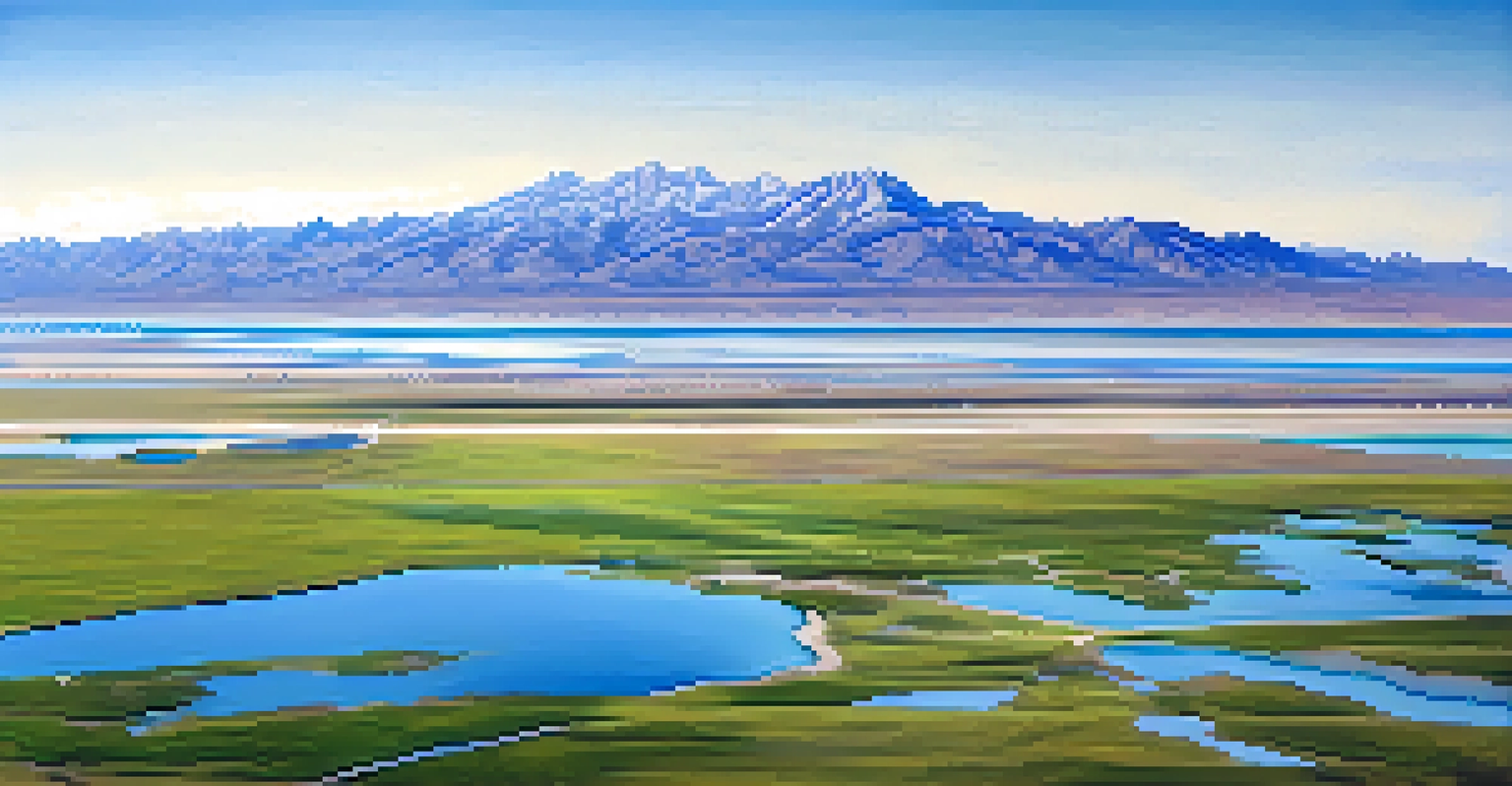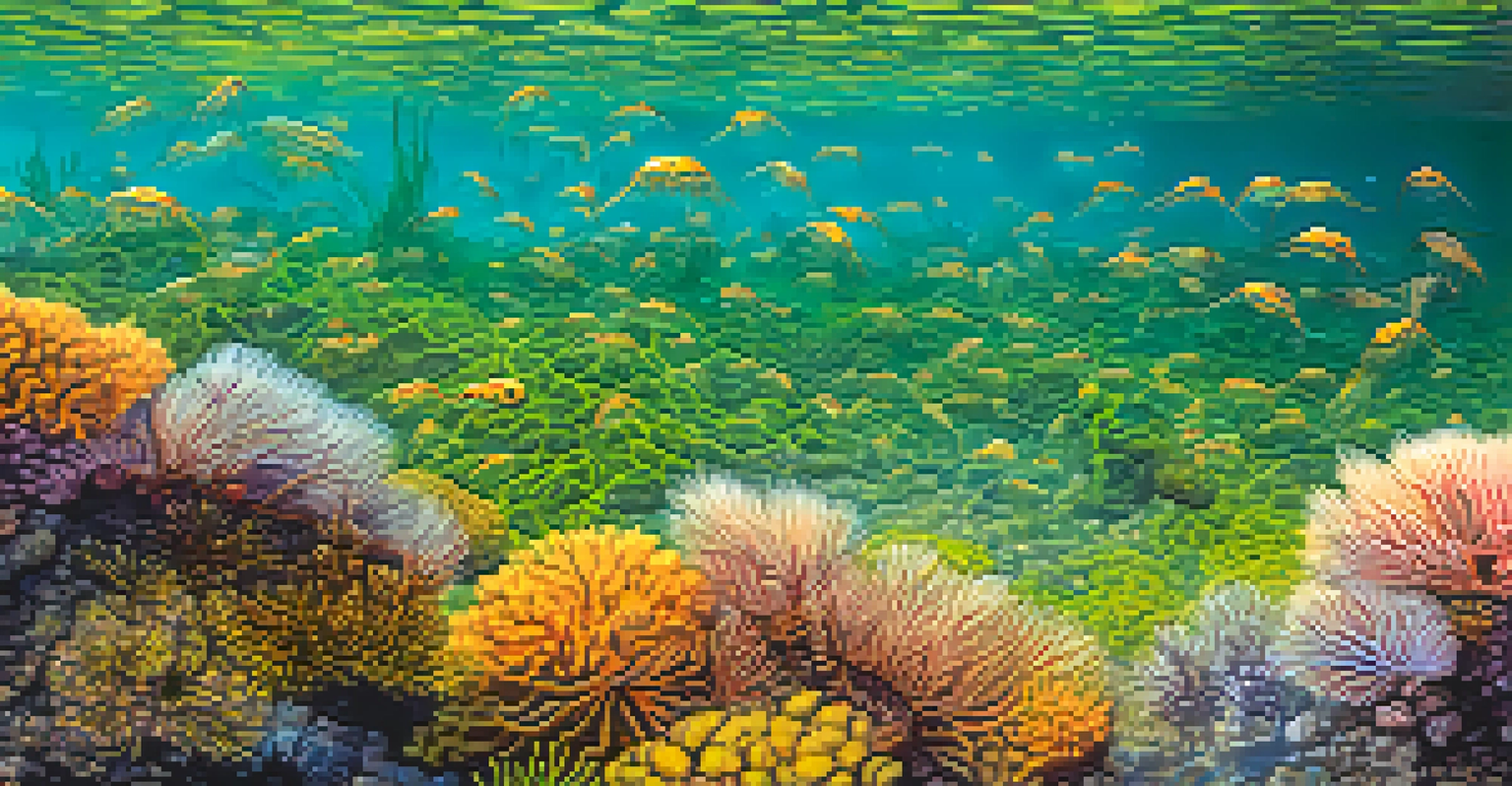The Great Salt Lake: Utah's Unique Landform Explained

Introduction to the Great Salt Lake's Unique Features
The Great Salt Lake, situated in northern Utah, is a remarkable natural feature known for its unique characteristics. It’s the largest saltwater lake in the Western Hemisphere, and its high salinity levels create a stunningly beautiful yet harsh environment. This vast body of water is not just a lake; it’s an ecosystem that supports diverse wildlife and offers a glimpse into geological history.
The Great Salt Lake is a reminder of nature's resilience and the delicate balance of ecosystems.
As you approach the lake, the first thing you notice is its striking color contrasts—ranging from deep blue to vibrant green due to the varying salinity and algae growth. The lake's unique chemistry not only affects its appearance but also influences the types of organisms that can thrive in its waters. This extreme environment provides a fascinating backdrop for both scientists and nature enthusiasts alike.
Understanding the Great Salt Lake is essential for appreciating Utah's geography and ecology. It serves as a vital habitat for migratory birds and other wildlife, making it a significant spot for birdwatching and outdoor activities. In the following sections, we’ll dive deeper into its formation, ecology, and cultural significance.
How Did the Great Salt Lake Form?
The Great Salt Lake has an intriguing geological history that dates back millions of years. It was once part of a vast freshwater lake called Lake Bonneville, which covered much of Utah and was formed during the last Ice Age. As the climate changed, this lake began to dry up, leaving behind the remnants we see today, including the Great Salt Lake.

This process of evaporation is crucial to the lake's formation. With no outlets, the water that flows into the lake primarily comes from rivers and streams, bringing along salts and minerals. Over time, as the water evaporates, these minerals concentrate, resulting in the high salinity that characterizes the lake today.
Geological History of the Lake
The Great Salt Lake was formed from the remnants of Lake Bonneville, a vast freshwater lake that existed during the last Ice Age.
The geological evolution of the Great Salt Lake is a fascinating story of nature's resilience and adaptability. Understanding its formation not only gives insight into the lake's current state but also highlights the dynamic processes that shape our planet’s landscapes.
The Unique Ecosystem of the Great Salt Lake
Despite its harsh conditions, the Great Salt Lake hosts a unique and thriving ecosystem. This saline environment is home to various species of brine shrimp and brine flies, which have adapted to the high salinity levels. These organisms play a crucial role in the food chain, supporting a diverse array of bird species that migrate to the lake each year.
In the midst of challenges, the Great Salt Lake stands as a testament to the beauty and complexity of our natural world.
The lake is particularly famous for its role as a stopover for migratory birds on the Pacific Flyway. During migration seasons, thousands of shorebirds and waterfowl flock to the lake, attracted by the abundant food sources. Birdwatchers from around the country come to witness this spectacular natural event, making the lake a prime location for ecological tourism.
The unique ecosystem of the Great Salt Lake exemplifies how life can thrive in extreme conditions. This resilience serves as a reminder of the adaptability of nature and the importance of preserving such unique habitats.
The Cultural and Historical Significance of the Lake
The Great Salt Lake is not only a natural wonder but also a site of cultural and historical importance. Indigenous peoples, including the Shoshone and Goshute tribes, have lived in the area for thousands of years, relying on the lake and its resources for sustenance. Their deep connection to the land underscores the lake’s significance in the region’s history.
In the mid-19th century, the lake gained prominence when Mormon settlers arrived in Utah. They named the nearby city of Salt Lake City, reflecting the lake's influence on their settlement patterns. The lake has since played a vital role in the state’s development, influencing agriculture, industry, and tourism.
Unique Ecosystem Supports Wildlife
Despite its harsh salinity, the Great Salt Lake hosts a thriving ecosystem that is crucial for migratory birds and other wildlife.
Today, the Great Salt Lake continues to draw visitors, researchers, and conservationists alike. Its rich history and cultural significance highlight the need for ongoing efforts to protect and preserve this unique landscape for future generations.
The Great Salt Lake's Economic Impact
The Great Salt Lake has a significant economic impact on the region, contributing to various industries and recreational opportunities. Salt extraction is one of the primary economic activities, with companies harvesting salt for commercial use. This industry not only supports local jobs but also plays a role in the state's economy as a whole.
Additionally, the lake is a popular destination for outdoor recreation, attracting tourists for activities like boating, birdwatching, and photography. The scenic beauty and unique landscapes offer a perfect backdrop for adventure seekers and nature lovers. This influx of visitors provides a boost to local businesses, including hotels, restaurants, and tour operators.
The economic benefits of the Great Salt Lake are intertwined with its ecological health. Efforts to promote sustainable practices and protect the lake's environment will ensure that both the economy and the ecosystem can thrive together.
Challenges Facing the Great Salt Lake
Despite its beauty and significance, the Great Salt Lake faces several environmental challenges. One of the most pressing issues is water diversion for agricultural and urban development, which reduces the inflow of water to the lake. This not only impacts its salinity levels but also threatens the delicate balance of its ecosystem.
Pollution is another significant concern, with runoff from nearby urban areas and agricultural lands introducing harmful substances into the lake. This can adversely affect the lake’s wildlife and overall health. Conservationists and local organizations are working tirelessly to raise awareness and implement measures to mitigate these impacts.
Cultural Significance and Economy
The Great Salt Lake holds cultural importance for Indigenous peoples and has significant economic impacts through salt extraction and tourism.
Addressing these challenges requires a collaborative effort among stakeholders, including local governments, residents, and conservation groups. By coming together to protect the Great Salt Lake, we can ensure its future as a vital natural resource and a cherished landmark.
Visiting the Great Salt Lake: Tips and Attractions
If you’re planning a visit to the Great Salt Lake, there are plenty of attractions and activities to explore. One of the must-visit spots is Antelope Island State Park, which offers stunning views of the lake and opportunities for hiking, biking, and wildlife spotting. The island is home to bison, antelope, and a variety of bird species, making it a great place for outdoor enthusiasts.
Don’t miss the chance to experience the unique sensation of floating in the lake! The high salinity makes it incredibly buoyant, allowing you to relax and enjoy the extraordinary landscape surrounding you. Just remember to bring water shoes, as the shoreline can be rocky and muddy.

Whether you’re interested in photography, birdwatching, or simply soaking in the natural beauty, the Great Salt Lake offers an unforgettable experience. With its breathtaking vistas and rich ecosystem, it’s a destination that should not be missed.